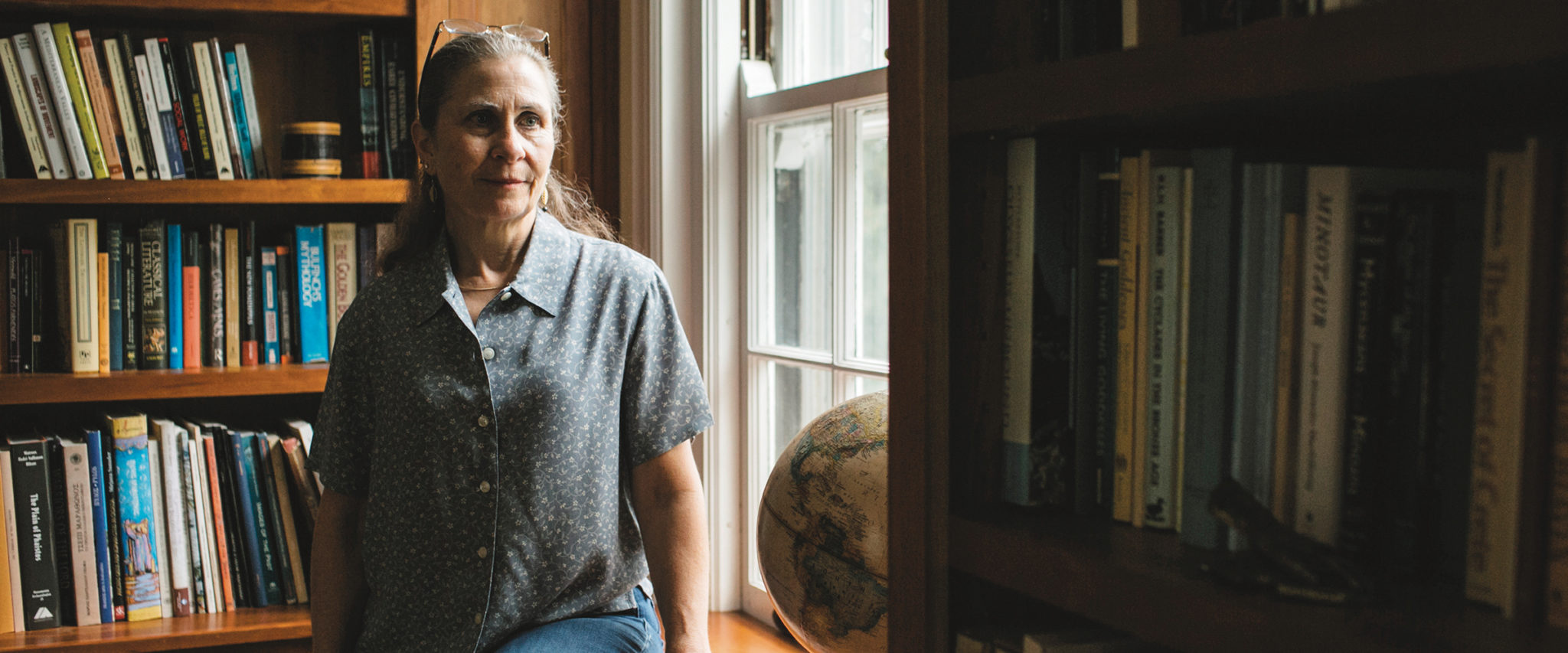Indiana Jones, Hollywood’s swashbuckling professor, may have battled Nazis (and snakes) to unearth the Ark of the Covenant using nothing more than wits and a bullwhip, but Hollywood is one thing. Real archaeology is quite another—where bullwhips aren’t as handy as, say, an industrial X-ray machine. Yet acquiring that technology is precisely what’s consuming real-life archaeologist Sharon Stocker ’81 on a chilly morning inside her offices at the Carl Blegen Library at the University of Cincinnati. “We can’t actually use a medical X-ray,” says Stocker, the petite, energetic woman behind the greatest Greek archaeological discovery of the last 50 years. “We can’t use a medical X-ray because they’re just for looking at bones. Metal is much denser, so you need some kind of industrial machine.”
By metal, Stocker means bronze, lots of it. But also gold and silver, in addition to amethyst, amber, ivory, and yes, bone, all of which Stocker and her team found inside the tomb of the Griffin Warrior in May 2015 during a scheduled dig in Pylos, Greece. The discovery made international headlines as the 3,500-year-old, intact warrior’s tomb was heralded as the richest excavation in a generation. (The deceased was named Griffin Warrior because he was buried with several images of griffins—animals with wings and talons of eagles, and the hindquarters and tails of lions—including an ivory plaque between his legs and a carnelian sealstone.) Along with the warrior’s skeletal remains, Stocker and her team extracted gold signet rings, a dagger and sword, a bronze and ivory mirror, semiprecious beads, and other significant objects. Stocker’s experience and scholarship led her to dig in a location she knew could yield interesting material, but to find an intact, unlooted tomb was a stroke of remarkable luck. To withdraw its priceless contents within six months was a feat of incredible dedication and diligence. Now the long, hard, expensive work of conservation carries on outside the media spotlight, and it’s a task that will likely consume Stocker for the rest of her career.
Stocker opens up her laptop and scrolls through a series of images documenting conservation efforts thus far. “This one is really interesting,” she says, pulling up a photo of what appears to be a clump of dirt. “It looks like nothing, I mean it really looks like nothing. But what we found is that it has holes. You can see that this is an edge, and it has holes.” What an X-ray examination revealed is a piece of ancient armor, with lacing holes at the edge clearly visible. “Though we found bronze in other areas, what this image shows is that this particular mass of bronze comprises a thousand pieces, and they all belong to a suit of armor. With the X-ray machine we can see where the edges are, where the holes are. So we should be able to piece it together.” Technology is leading archaeologists like Stocker into territory they never thought they’d see, with expenses well outside the endowments and budgets of even renowned programs like that at the University of Cincinnati.
An X-ray (and a technician to operate it), however, is just one piece of the conservation puzzle that will draw in multiple disciplines like genetics, chemistry, geology, and anthropology. Lynne Schepartz and Tobias Houlton, two physical anthropologists at the University of Witwatersrand in Johannesburg, South Africa, have already created a digital facial reconstruction using the Griffin Warrior’s skull. DNA analysis will be done to try to determine where, exactly, this man was from; using available technology, even the origin of the metals used in the grave objects can be pinpointed. “Archaeology isn’t just about classicists. We employ a whole range of people,” says Stocker. “Not to make any money,” she adds, laughing. “I don’t have any money, but we offer opportunities for all kinds of people.” And opportunity—in this case, a missed one—is where history was made.
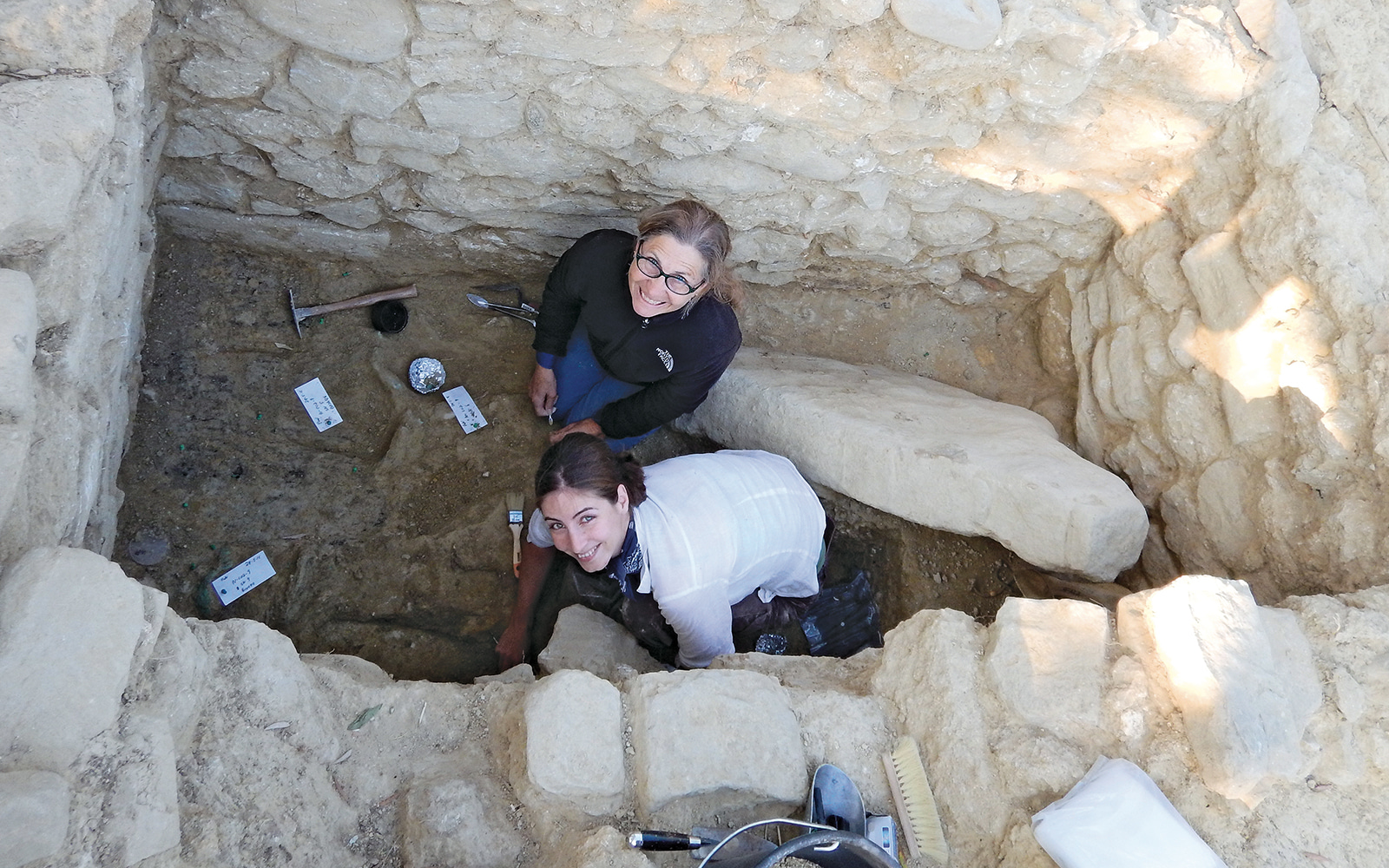
It was an extraordinary year that almost wasn’t. By her own description, Stocker’s 2015 dig season started badly. She and her husband, Jack Davis, the Carl W. Blegen Professor of Greek Archaeology at the University of Cincinnati, wanted to dig in a currant field near the Palace of Nestor in the hopes of finding ancient housing remnants, but that plan didn’t pan out. The application and vetting process for excavation permits in Greece is lengthy, often taking two years or more to secure a site for a six-week term. The nearby olive grove that yielded the Griffin Warrior’s tomb was their plan B. There’s very little flexibility, and if you get a permit to dig, you dig, whether you get your preferred site or not. “The place where we were going to dig fell through; then our housing fell through,” explains Stocker. “It was a really rough start.”
Once the archaeologists were settled in the olive grove, however, a corner of a stone shaft quickly revealed itself. And as so often happens upon receiving life-altering news, Stocker and Davis still debate where, exactly, they were when field assistant Flint Dibble, who had been excavating the site with Alison Fields, startled them with a text: We’ve hit bronze. “We were somewhere,” says Davis, summing up the bewilderment of that day in May, two years ago. The museum? The workshop? The bank? It hardly matters now. “We went back and never left the field after that,” says Stocker.
The discovery of bronze was significant in itself—ceramics are far more common finds—but once gold was found, Stocker and Davis weren’t so much elated as panicked. “Normally, the policy of Greece, when you find an intact grave, is to dig it very quickly because of the security risks,” Davis says. “We’ve known people who’ve had graves looted while they were digging, even while they’re guarded.” A stunning gold braid necklace trapped under a bronze basin required weeks of work to extract, and Stocker had to scramble to get funding for round-the-clock security. In addition to security concerns, Stocker was already calculating the cost of conserving everything they were bringing out of the ground. “We freaked. We freaked out when we found the metal because it had huge implications,” she says.
They found the tomb untouched, but not undamaged; at some point in the last 3,500 years, the stone slab covering the shaft fell in, crushing the skeleton and the armor beside it. The smashed pieces of bronze had to be treated and secured with gauze before being removed, so in addition to extra money for security and extending their housing and car rental, Stocker had to find a field conservator, uncommitted to another project, to come work with them immediately. “Bronze continues to corrode once it comes out of the ground, and it’s already corroded from being there for 3,500 years. Unless we treat it and clean it, it’s going to continue to deteriorate. It’s a very specialized process, very slow, and very time-consuming,” she says.
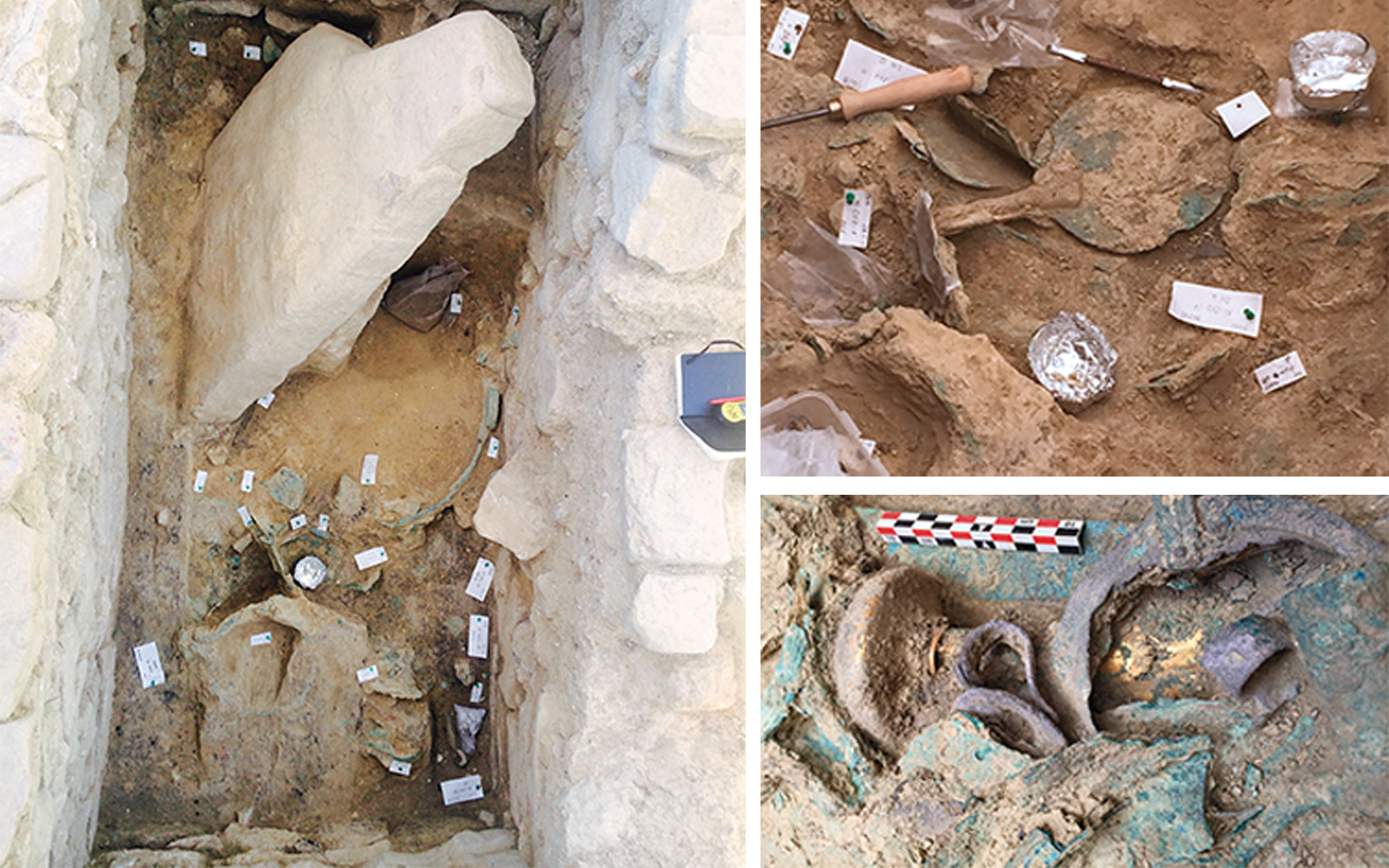
As June wore into July, their students and summer team began to disperse, back to school and other obligations, which left Stocker, Davis, and conservator Alex Zokos to work on their own through October. Many days, Stocker worked alone in the grave shaft, a rectangular space about the size of a kitchen table, driven by both pressure and excitement. She forfeited two planned sailing trips and landed briefly in the hospital, thanks to the heat and her own determination. “It’s really addicting to keep finding things, and I’m not very good at taking a break,” she says. By the time the work was finished, Stocker and her team had pulled out an exhaustive list of artifacts, including four gold rings, two gold cups, six silver cups, a 30-inch-long gold necklace with bead pendants, a three-foot-long sword with a gold hilt, a dagger, and a staff topped with a bronze bull’s head. They also found 50 sealstones, intricately carved in Minoan style, six decorated ivory combs, a bronze mirror with a decorated ivory handle, and over 1,000 small, semiprecious beads of carnelian, amethyst, amber, and agate.
The excavation could have been completed in October 2015, but Stocker remains living in Greece full time and working with specialists, conservators, and the Greek Ministry of Culture as they unlock and interpret the mysteries of these ancient objects. Their findings will shape our understanding of history and the rise of Western civilization.
The 30-something male buried in the tomb was most certainly an important figure in the Mycenaean society of mainland Greece at the time, just before the era that saw the rise of Mycenaean palaces like that of Nestor. Was he indeed a warrior? A leader? Had he migrated from Crete? Ongoing conservation and study could yield answers. Chemists, geneticists, geologists, and yes, the desired X-ray machine could help pinpoint his origins and unlock the mysteries of his end. The four exquisitely carved gold rings found in the tomb are consistent with the expert craftsmanship of the Minoan culture, originated on Crete, which lies over 100 miles to the south of Greece’s mainland isthmus known as the Peloponnese. “This tomb greatly strengthens our impression that around 1500 B.C., Minoans on Crete and Mycenaeans on the Greek mainland were closely involved with each other,” says Cynthia Shelmerdine, the Robert M. Armstrong Centennial Professor of Classics, emerita, at the University of Texas at Austin, and a noted Aegean Bronze Age scholar.

During the Early Mycenaean period, circa 1700-1400 B.C., Minoan palaces on Crete flourished and then failed, she says, and the Mycenaeans emerged as new elite players in the political and economic world of the Eastern Mediterranean. “The tomb dates to circa 1500-1450 B.C., so the Griffin Warrior was one of these players. Soon after his death, the mainland palaces were constructed, and we find Mycenaeans in charge of administration at Knossos on Crete,” says Shelmerdine. “So he represents that formative time when the Mycenaeans looked and moved beyond their own limited world and became a regional power.”
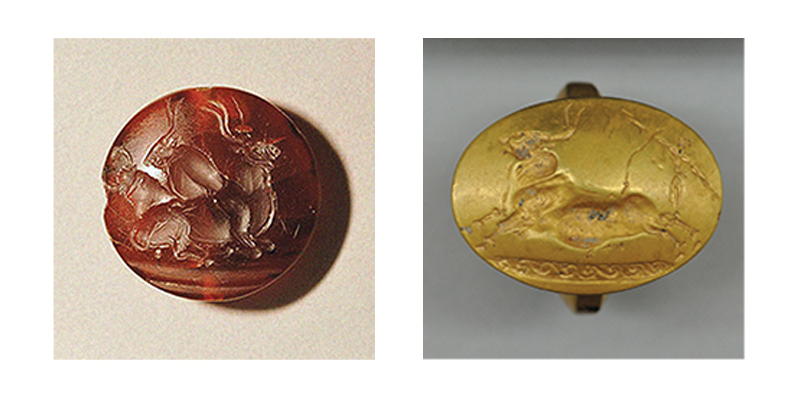
A carnelian sealstone engraved with three bulls (below, left); a gold ring with Cretan bull-leaping scene (below, right).
Shelmerdine has known Stocker since the early 1990s, when they met on the Pylos Regional Archaeological Project. Stocker worked as Shelmerdine’s main assistant in organizing the study of the pottery and other artifacts recovered there. “To do that job well,” says Shelmerdine, “you have to be organized, as Shari certainly is. But the really talented analysts have an innate flair for the material—a sort of sixth sense that helps them understand it. Shari is among the very best I have taught.” To illustrate Stocker’s field instincts, Shelmerdine says, “Shari has the ability to pick up a small potsherd and judge which way it goes, whether it comes from a large or small vessel that’s ‘open’ like a bowl or ‘closed’ like a jar, and she knows the Mycenaean repertoire well enough to reconstruct the whole pot in her mind’s eye. She is meticulous about details, but she also sees the bigger picture—that these artifacts connect us to the real Mycenaean people we are so curious to know better.”
Stocker grew up outside of Chicago, in a family with strong ties to Denison; both of her parents are Denison alums, as are an aunt and uncle. Stocker graduated with a classics degree, but that’s not where she began. “I started as a biology major,” says Stocker. “I didn’t know what I wanted to do. I’ve always been interested in history, in Egypt, in the things people found, and I liked traveling. I suppose now it looks like a natural fit, but I don’t think that I wanted to be an archaeologist from an early age. I’m from a fairly small town. I don’t think I knew an archaeologist.”
But often, all it takes to change one’s trajectory is the right teacher at the right time. As a Denison freshman, Stocker took a course in classical civilization with Amy and Michael Gordon in the history department. At the time, they offered study trips to Greece and Rome during the month of January, and soon Stocker was off on her first trip outside the United States. “I fell in love with Greece,” she remembers. “We went to Delphi on a cold, dreary Monday in January 1978. All archaeological sites are closed on Mondays, but I guess the professors thought Delphi, being a major tourist site, might be open. It wasn’t. Delphi is located in the mountains, and on that particular day, the clouds were covering the valley below the site. I remember looking up through the gate at the amazing ruins and then out into a sea of clouds below us and knew that I had to come back. That was it for me. I’ll never forget that day, or the details, because it was life-changing.”
Greece’s gravitational pull on Stocker has led her to live there full time since 2007. That’s when Davis became director at the American School of Classical Studies in Athens, and they took up residence for a five-year stint. They were due to return to the States in June 2012 when a project began to construct a new shelter over the Palace of Nestor. After six weeks back at home, Stocker returned to Pylos to work on that project while Davis remained in Cincinnati to resume teaching. She continued working there until the 2015 dig season began in May, and then came the Griffin Warrior, and Greece changed her life once again.
The discovery of this ancient tomb comes at a time when archaeologists have unprecedented technological tools at their disposal. “It’s leading us into areas we never thought we would go,” says Stocker. “It’s a blessing and a curse. We had a plan for a five-year excavation with a very reasonable budget. To conserve this material in a way that is ethically responsible will cost more, probably, than all of the five years of research that we had planned.”
The good fortune of finding such a rare, single tomb of an ancient Mycenaean elite citizen flows two ways, both to Stocker and to her Griffin Warrior. “Shari and Jack are extremely experienced archaeologists. They dug this with such care, it’s the best-excavated tomb in Greece,” says James Wright, the former director of the American School of Classical Studies in Athens, whose five-year term ended last June. “They brought in all the best equipment and personnel. They’ve done a superb job and will continue to do the most cutting-edge scientific work in studying this burial, because they’re using all the technological tools they have. They’ll be able to use this tremendous power to squeeze every bit of information out of this individual and the objects buried with him.”
Stocker remains in Greece for the foreseeable future, working every day in the archaeological museum near Pylos, around the area with other team members, or with specialists processing material from the grave. And then there’s that X-ray machine to fund. “We need to purchase the X-ray, transport it to Greece, build a lead-lined screen, arrange for training for our Greek and foreign colleagues, and hire a conservator to operate the machine,” says Stocker. “All told, the cost is $250,000.” But the team is close, with just $25,000 left to raise.
Stocker allows herself an early-morning run and a yearly sailing trip, but there isn’t time for much else. “This has been a game-changer, and it requires full-time management,” Stocker says as she pulls up yet another photo of another humble clump of soil. Hidden within is an extraordinary bronze star, its rays and center made of gold. Says Stocker, “The X-ray is really important. How can you go at this with a scalpel when you don’t know what you’re going to find underneath?”
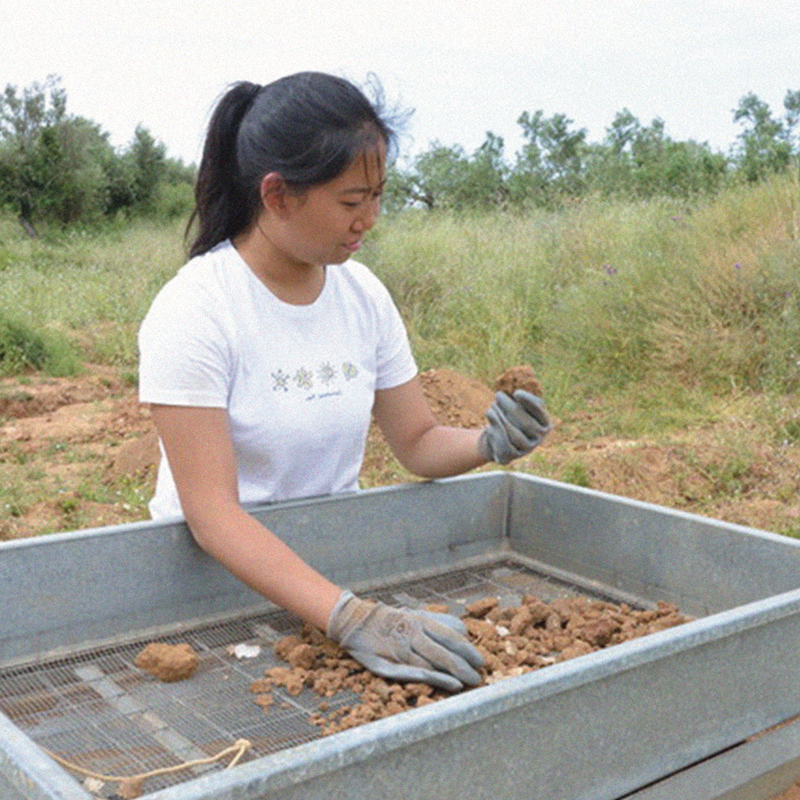
How did you get this opportunity? I found out about it through the Knowlton Center. I had never been to Europe and I knew it was an opportunity I couldn’t pass up. I applied and Shari got back to me, and said she’d love to have someone from her alma mater along. The dig was seven weeks, and I got involved in the field work as well as the cataloguing and cleaning of artifacts.
For a first field experience, you kind of hit the jackpot. We started finding indicators that this was something big about halfway through the season. I got a deeper appreciation for what goes into it. You really are sifting through a lot of dirt. I wasn’t working on that specific plot, but we all worked together, and you find things as a team. It’s time-consuming, but even the littlest thing found, like a gold flake or a bead, could mean something.
When did you realize that this was a big deal? When Shari started calling specialists from the Greek Ministry of Culture. It started getting bigger and bigger.
You majored in environmental science and economics. How did this experience inform your studies? We talk about monetary theory and financial sovereignty in class, so it was interesting on a micro scale. It was the time of Brexit and the Greek financial crisis, so we were worried about cash and if we could use the ATMs. We had Greeks on the team, and we talked about the economy and how hard it was to put food on the table.
Aside from being part of one of the most significant archaeological finds in recent history, what else made your time in Greece memorable? Going to Olympia, where the first Olympic games were held, and the Acropolis, which really got me into mythology. The architecture in Greece is so fantastic. I miss the food every day. There is nothing like a Greek tomato. It cannot be replicated here.
Sharon and her team have taken other Denison students along to Greece. Any advice for fellow students? Bring a lot of sunscreen. Bond with your team and the locals, learn the culture and the language, and talk to people. They’re interested in learning about you, too.

